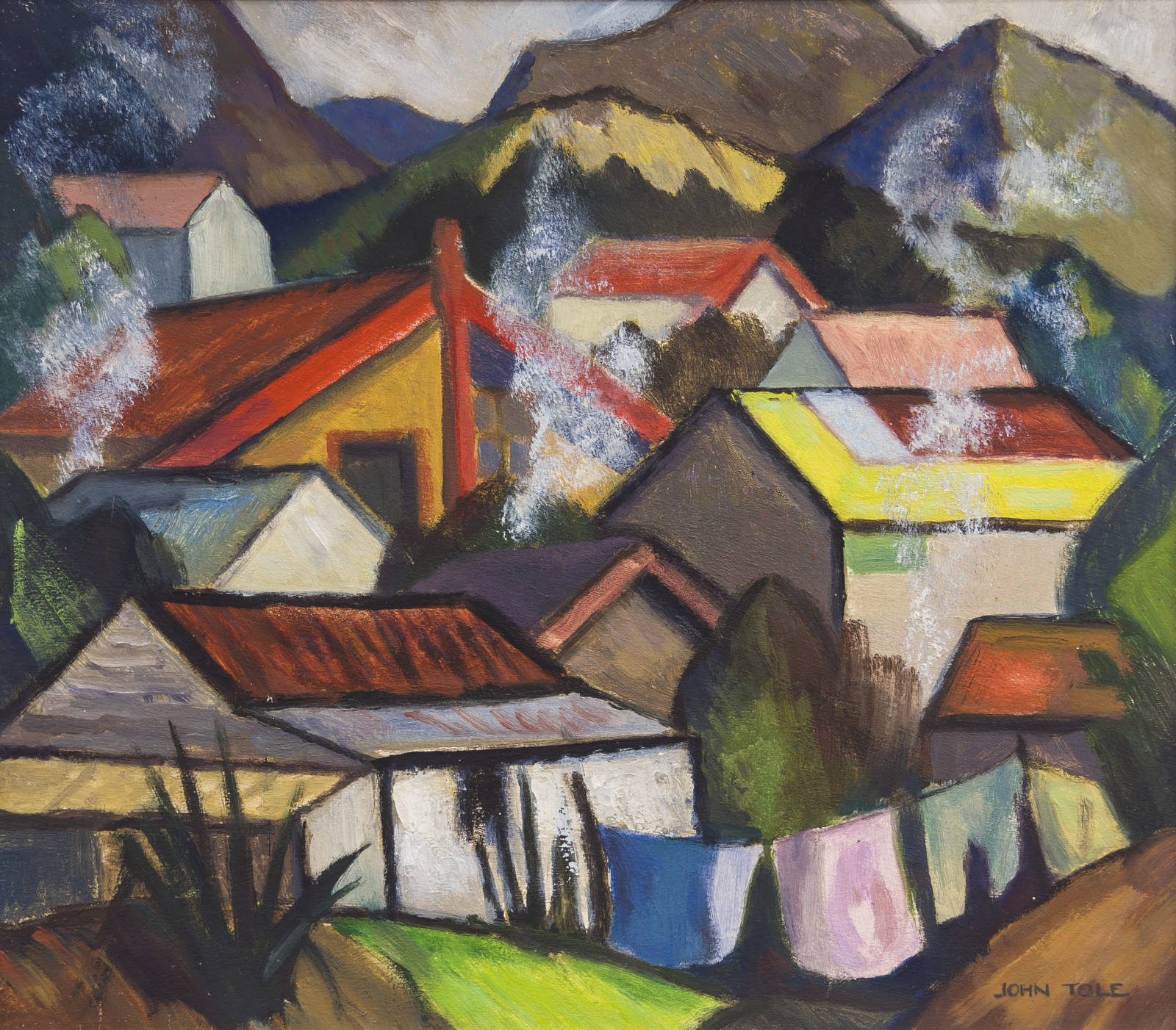TOLE, John;
Māori Village, Rotorua
c.1950
Oil on board
340 x 390mm

A very similar painting, titled Māori Dwellings appears in Arts Year Book 7 from 1951, suggesting that this work was created about this time.[1] Another oil with a Rotorua subject, At Whakarewarewa, was included in the 1951 exhibition of the Thornhill Group. The show was held at the clubrooms of the Auckland Society of Arts, Victoria Arcade, Tāmaki Makaurau.
The following two texts were written for Te Huringa/Turning Points and reflect the curatorial approach taken for that exhibition.
Peter Shaw
John Tole and his brother, Charles Tole, both attended Elam School of Art, Tāmaki Makaurau, where they came under the influence of John Weeks (1886–1965). The Tole brothers would often have travelled to Rotorua, where they, like Weeks, were friends with Wilfred Stanley Wallis, a local doctor who shared their interest in modern painting. They were fringe members of what the painter Melvin Day—who in 1945 had gone to the area to teach and shared a studio with Wallis—has called ‘the Rotorua Connection’.
In this attractive painting, the ability to balance tones within a composition and elements of the cubistic disintegration of form are possible evidence of Weeks’ influence. The distinctive roof gables of Whakarewarewa were as appropriate a subject for Tole as those of L’Estaque were for Georges Braque.
Jo Diamond
The fascination with architectural forms sits at the heart of this painting, though unlike his other paintings, Tole refers here to Māori people and their lifestyles. The colourful, angular shapes, mainly of rooftops, have the added embellishment of the gabled roof and maihi of a wharenui, snugly nestled in the middle of this village. The implied tekoteko adds another Māori element to this painting, as do the flax-bushes that were typically used for weaving everyday and special-purpose kete. Clothing hung out to dry is also a common sight in such a village and its inclusion adds a further human element to the painting. The rising smoke typifies this village as one that still relies upon open fires for heating, cooking and rubbish disposal. If it was not for the painting’s title, this village scene could be set from numerous locations in Aotearoa where predominantly Māori communities once resided in the 1950s.
Now, most Māori people are city-dwellers, a consequence of major urban drift that occurred after the Second World War. By then, rural life had become economically untenable for many Māori people, often largely due to government economic policies that resulted in Māori land title fragmentation. Indeed, continually changing land title legislation, confiscations for various reasons, the erosion of customary rights and the short-sighted over-commercialisation of natural resources dramatically and negatively altered Māori family-based economies and relations that had previously stood the test of time.
The novelty of Tole’s modernist use of colour in association with the theme of Māori village life in the 1940s and 1950s remains palpable in this work. None the less, for some of its viewers, especially, but not only, those Māori who can still associate with villages such as this, memories of economic hardship and disempowerment spring all too easily to mind.
[1] Eric Lee-Johnson (ed.), Arts Year Book 7 (Te Whanganui-a-Tara: The Wingfield Press, 1951), 66.
Inscriptions
MAORI VILLAGE – ROTORUA / JOHN TOLE / AUCKLAND. / 10gns [label verso]Exhibition History
Te Huringa/Turning Points: Pākehā Colonisation and Māori Empowerment, Sarjeant Gallery Te Whare o Rehua, Whanganui, 8 April to 16 July 2006 (toured)
Provenance
?–
Fletcher Trust Collection, purchased from Webb’s, Tāmaki Makaurau

